(This is an element of ‘Lighting – Burners & Controls‘)
As discussed under ‘open flame burners’ and also ‘large lanterns’, the growth in demand for increased lighting performance was unstoppable. The burners and the lanterns had become truly enormous. To some it was almost as if pure lighting power had become the goal as opposed to providing a sufficient or suitable amount of light for any particular street or location! The electricians were beginning to make inroads with their ‘arc’ lamps. Every time a road was lit by electricity the gas companies would install a string of high performance gas lights to effectively eclipse the competition.
William Sugg had produced the ultimate in multi concentric ring Argand burners and lamps providing up to 400 candle power as well as multiple flat flame burners which were quite capable of competing and beating anything the electricians could produce – and this was several years before the advent of the gas mantle.
The timely invention of the incandescent gas mantle, however, completely revolutionised the whole of the gas lighting world. At a stroke it was possible to obtain lighting performances consuming a quarter of the amount of gas previously required with the consequent reduction in heat. – Not that it was an easy step.
William Sugg was the first company in the UK to obtain a licence to manufacture the gas mantle. It did not last for long as William found that Welsbach did not provide any information as to how the process should be achieved. William, in his own inimitable style, set up a small plant in his home to discover the best way of manufacturing the product and then transferred this to the factory. However, the nature of the early mantles was such that they were attached directly to and sold complete with the burner. Unbelievably fragile, many purchasers would find their mantle was broken before they reached home! To achieve any replacement the burner had to be returned to the factory.
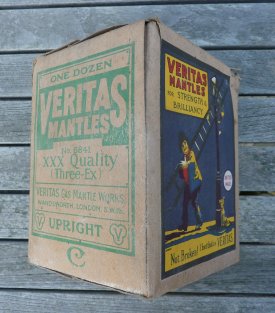
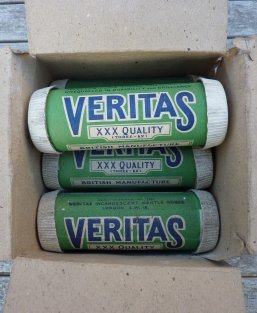
These pictures illustrate a box of the early Veritas upright gas mantles untouched after as much as 90 years, which proves perhaps that, although still fragile, the mantle achieved a level of strength suited to the task for a century!
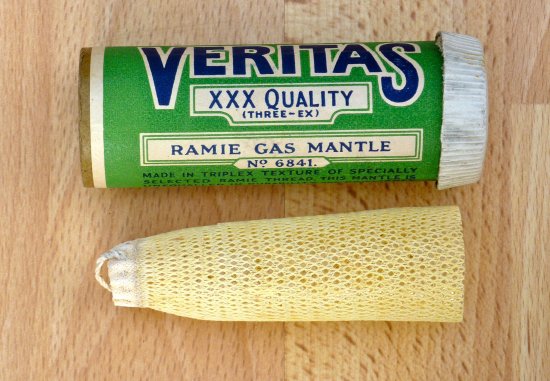
When Stuart Hall saw the picture above he sent me the picture below of his version of the same mantle in a red box. As you can see the red version is XX Extra Quality against the green XXX Quality. It’s not really obvious which one is the higher quality! Stuart purchased the remaining stock – 3 dozen, in the Old Kent road, possibly at Falk Stadelmann’s, prior to 1972. He told me that he used a couple about 40 years ago (mid 70’s) for a late Victorian table lamp! Stuart was brought up in Dartford, Kent and sent me a document given to new customers in the 1840’s giving the scale of charges for different burners many years before the mantle. This has been added to ‘burners – introduction‘
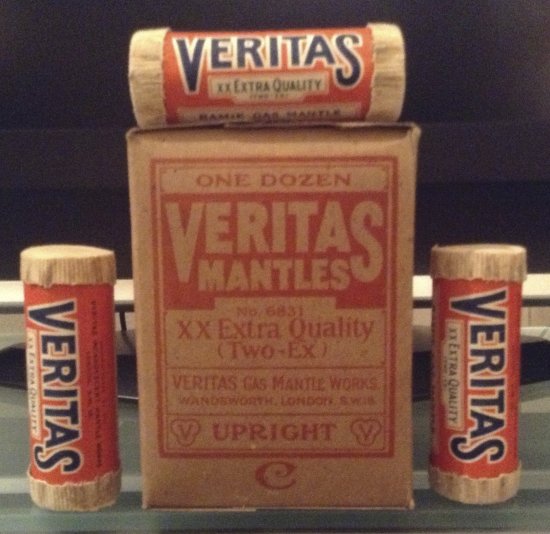
Because the open flame jet pointed upwards, the first mantles were developed to work in the same way, which is why they are called “upright” mantles. The glass tops of the early box lanterns progressively became obscured, firstly with opal glass and eventually with metal tops providing a reflecting surface to drive the light down to the road where it was really needed. The glass tops had been useful when the only lighting was from the street and some of the light would penetrate into the bedrooms of the houses immediately beside the road.
A short lived Mantle Adaptation.
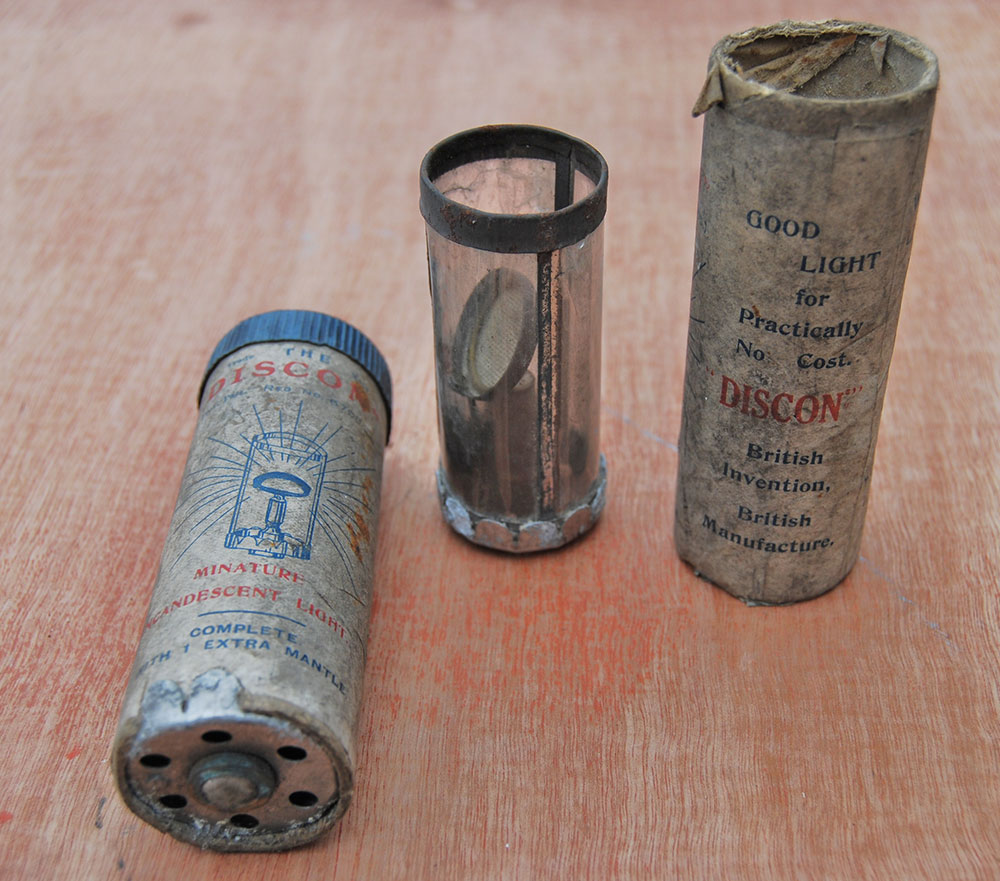
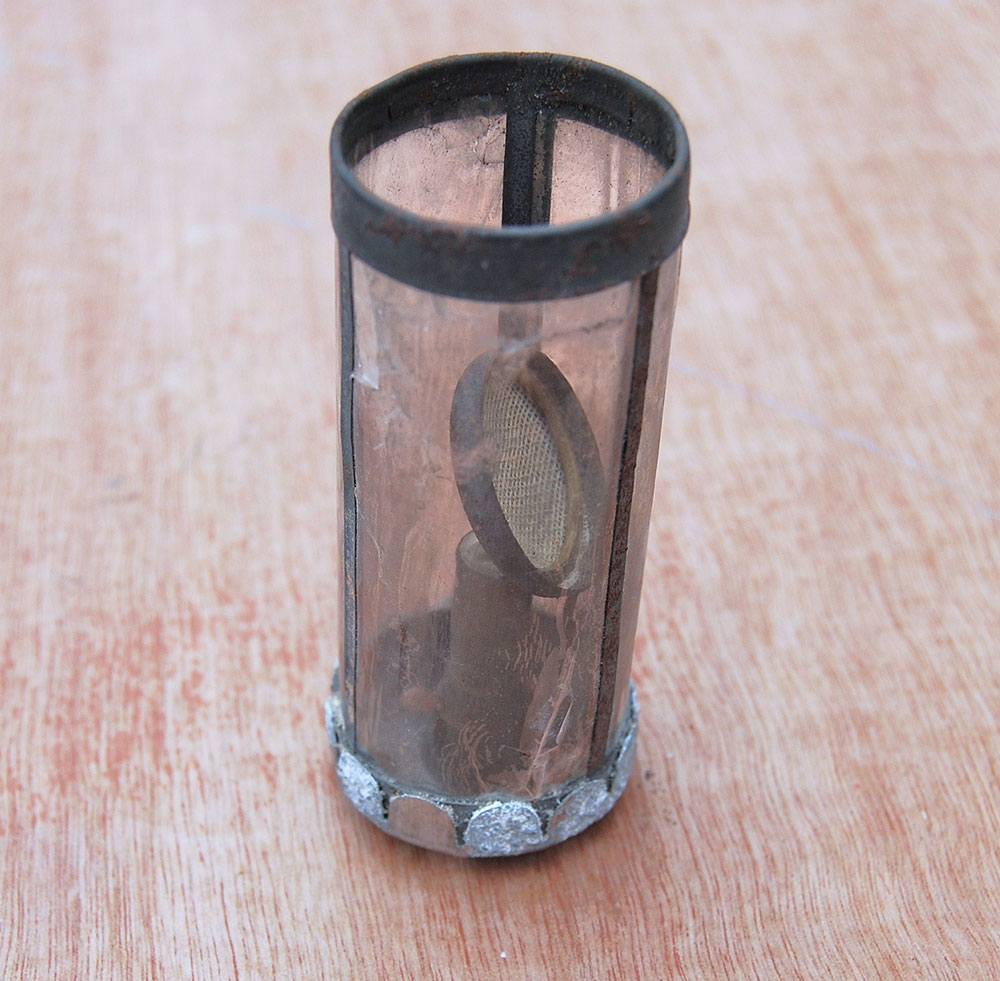
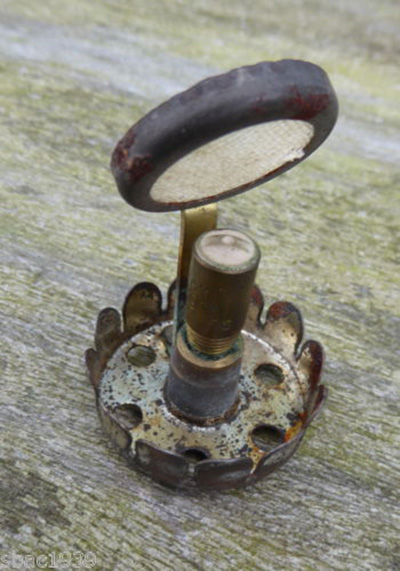
This is one of at least two devices that used a flat piece of mantle fabric mounted in a small frame attached or clipped onto an open flame burner. In the ‘Discon’ – doubtless named after the ‘disc’ of mantle fabric – it was sold as a complete burner assembly that could simply be screwed in place of a normal open flame jet. As you can see it even had a mica sleeve. This is quite a sophisticated arrangement compared to the other that I believe was called ‘Magna’. In this ‘mantle’ the piece of fabric was mounted in a small brass square frame with a clip attached that allowed it to be simply clipped onto a conventional open flame jet. (If anyone has a photo of this device I would like to add it. The last one I saw was in the London Gas Museum (now extinct) and I have not been able to find the photo – so far!)
The following three instructions were provided with the Discon burner. CLICK on image and then click again on the cross top right to enlarge either to make them readable.
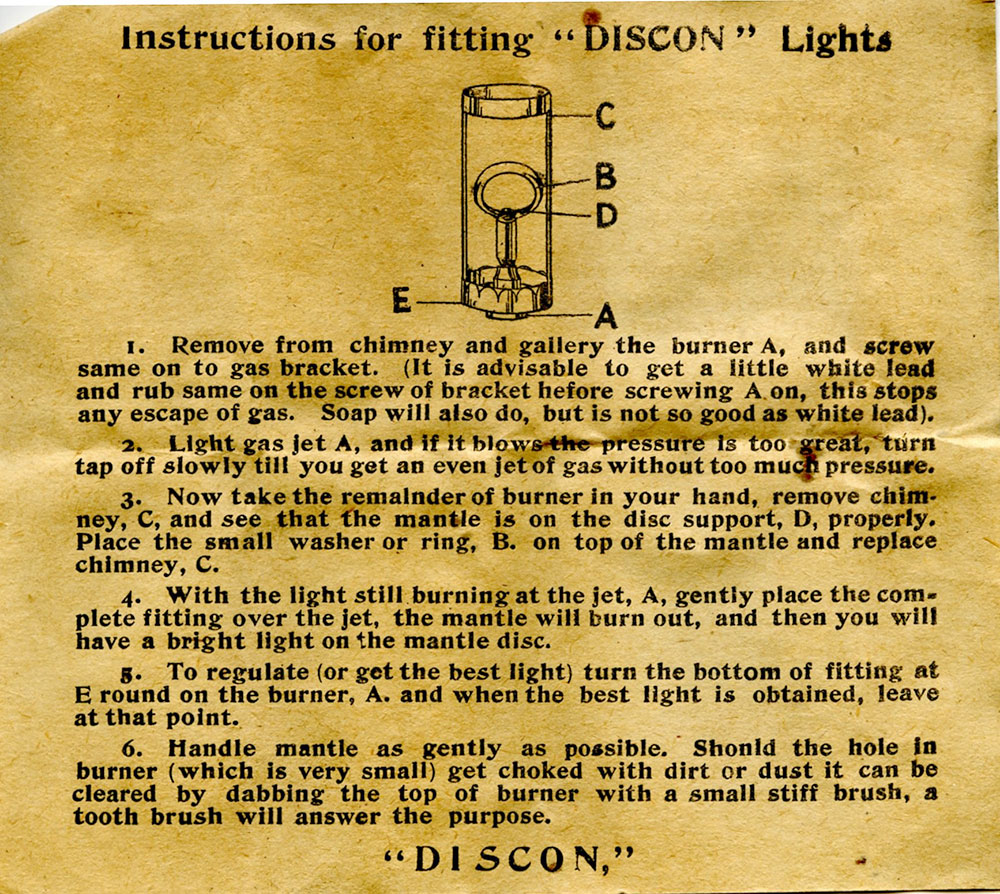
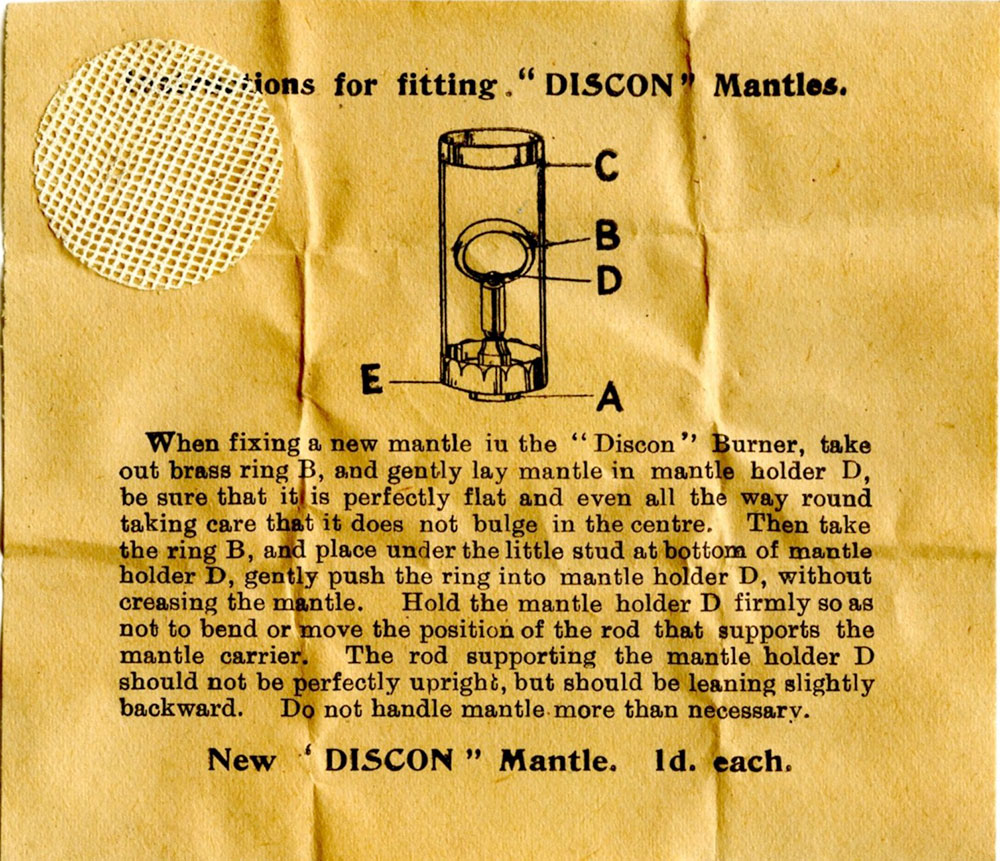
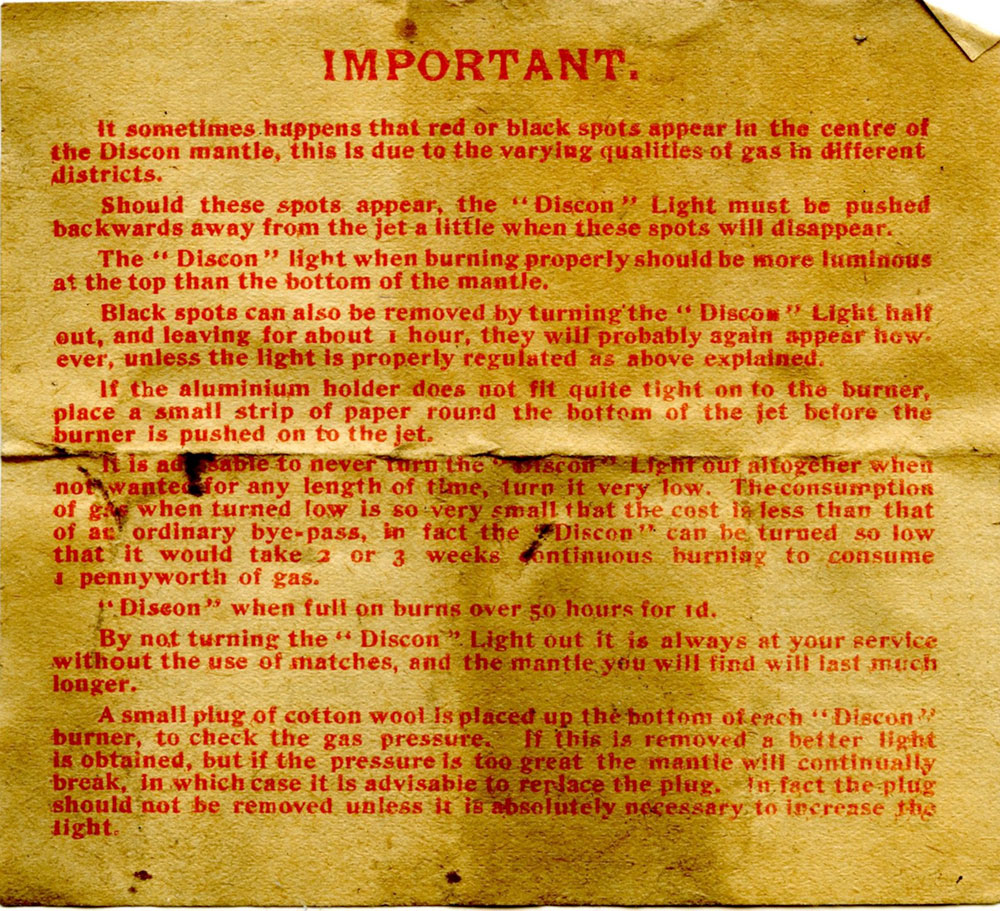
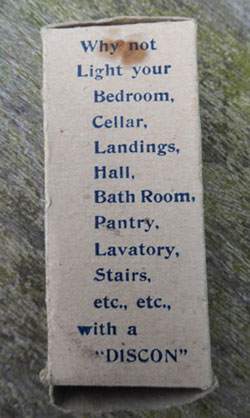
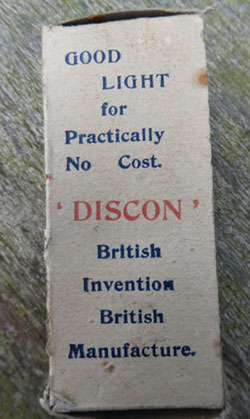
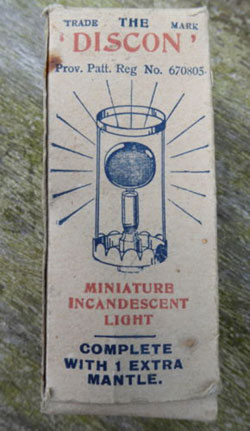
Inverting the mantle
As with so many developments, a step such as inverting the mantle so that it points downwards in the direction that the light is actually required, looks so obvious that one wonders why it took some time to reach this stage. Early literature on the Windsor lantern shows that the upright mantle was the first light source offered in this lantern designed in 1898 so the general introduction of the inverted mantle was not until the 20th century.
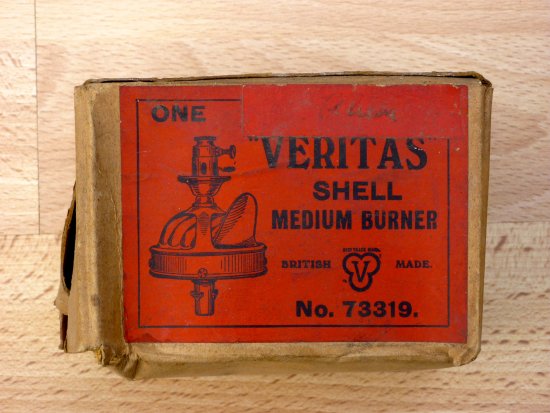
Several of these unused early Veritas ‘Shell’ burners in their original boxes were stored along with the upright mantles shown above by a man who lived in a gaslit house in Tunbridge Wells and was determined to hold enough spares for life!
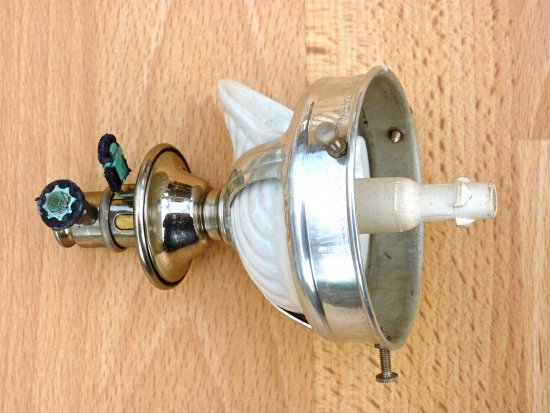
—————————————
Hard Inverted Mantle Sizes
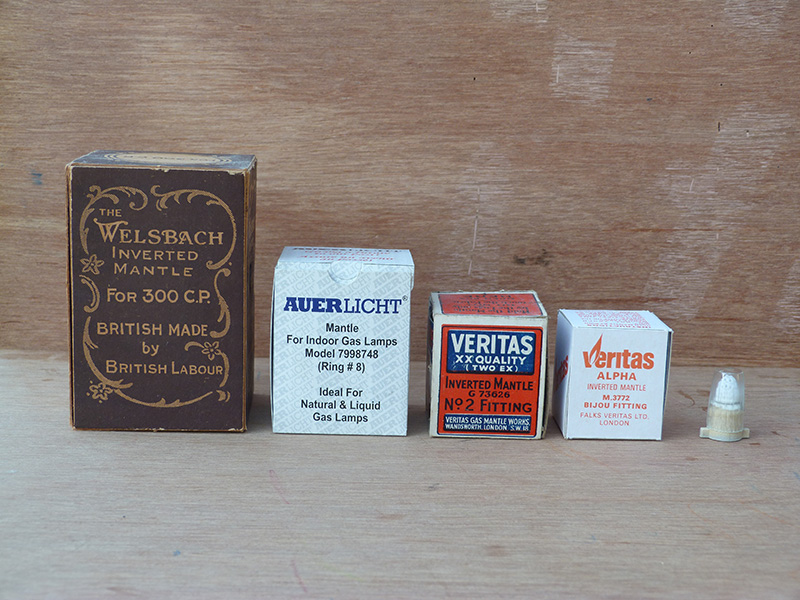
The pictures above and below show from left to right, a No.4, a No.3 also called ‘Universal’, a No.2 and a No.1 or ‘Bijou’ mantle. Finally, on the right is the tiny ‘Limina’ mantle designed for small warning lights.
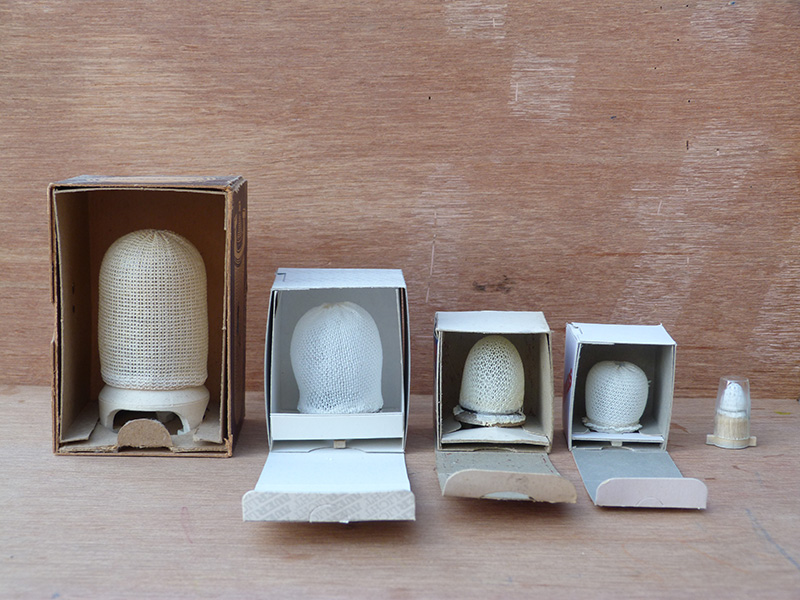
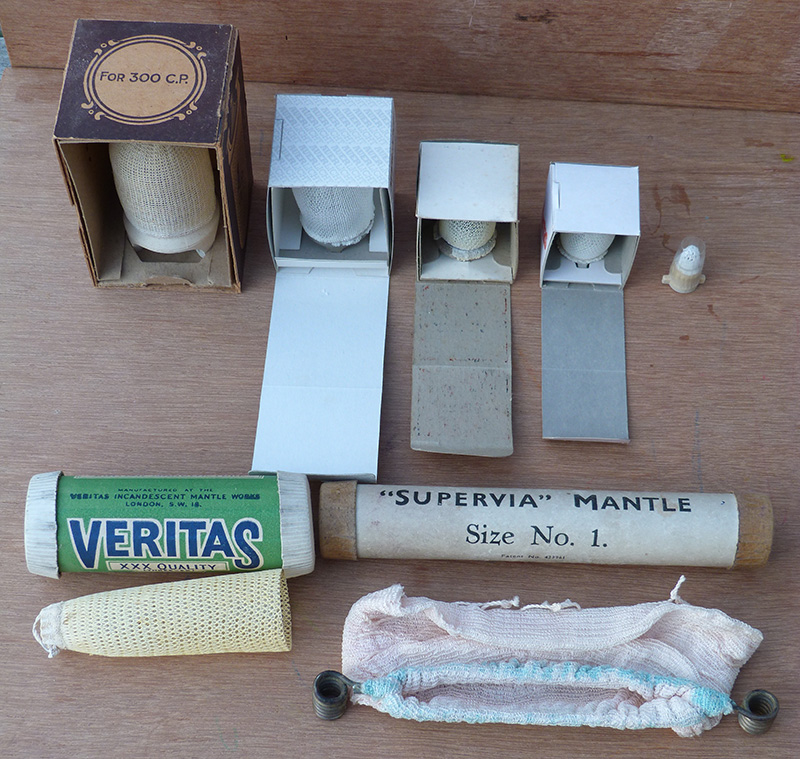
The picture above shows, in addition to the hard inverted mantles a Veritas ‘C’ Type upright mantle identical to the ones shown above in red boxes but the XXX Quality version in the green box. The ‘Supervia’ soft mantle size No.1 is a much later mantle than the others designed for more powerful street lighting applications utilising elongated or a series of nozzles discharging into the one mantle which is rectangular and thus produces the majority of its light from the sides of the mantle.

Mantle boxes are also collected for their interesting variety. The Veritas box on the left was the final offering before they stopped manufacture but, as you can see, the red and green colours were previously used to indicate a ‘quality’ level.
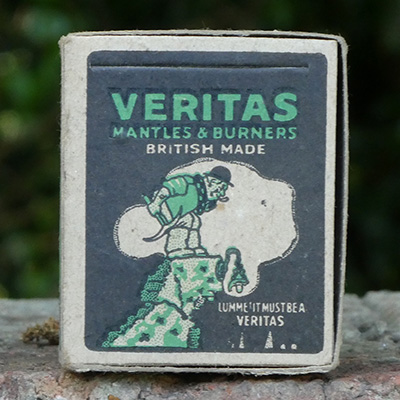
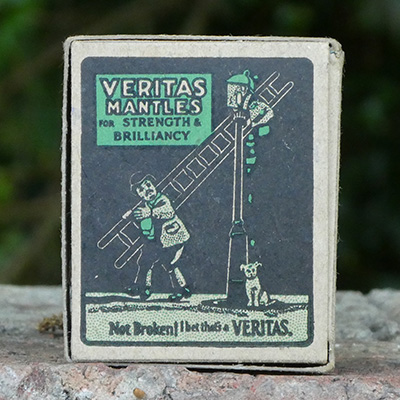
The two sides of this green Veritas box have probably their best known adverts of all time!
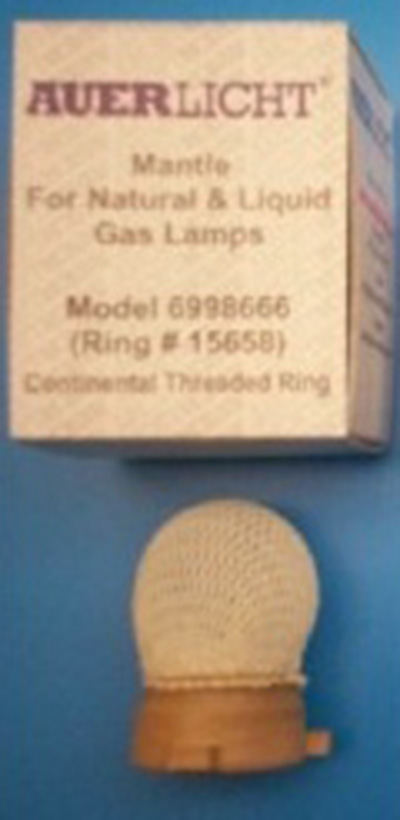
The rather poor picture above shows the ‘Truma’ mantle with an internally threaded ring manufactured to fit on a matching threaded nozzle to comply with regulations for Australia. This arrangement ensures that all the products of combustion pass through the fabric rather than between the ring and nozzle as with the ‘normal’ 3 – lug hanging arrangement.
Below shows you the internal thread on the mantle ring.
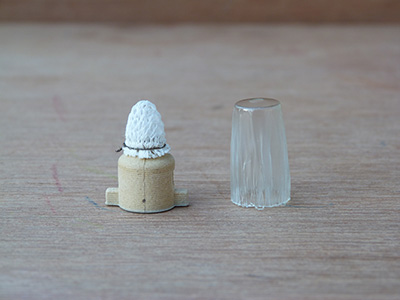
As mentioned in the comparison picture above, this is the ‘Limina’ mantle that was manufactured for very small signal lamp applications such as the one below from Hyde Park many years ago. The plastic cap is simply for protection during transport and storage.
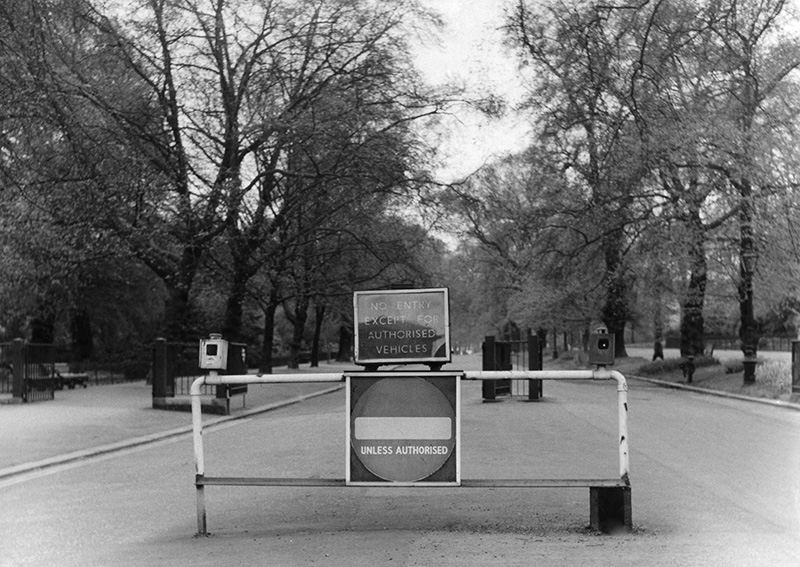
Picture by Dorron Harper
The Sugg “Stronga” Mantle
This replaced the earlier super fragile one amid much sales hype as can be seen on this box label indicating that they could be seen from Mars!
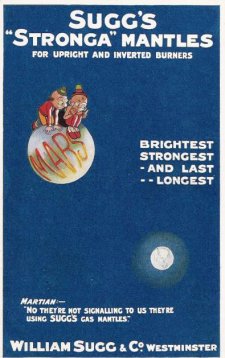
The inverted mantle is roughly hemispherical in shape at the bottom with parallel sides which are attached to a ceramic ring that fits to a matching nozzle. The aim is to fill the mantle with a hot flame that causes the mantle fabric to incandesce brightly. Over the years the mantle has changed in size along with the supporting nozzle.
Basic Sizes and Number References
To avoid confusion the most common references used to describe the hard inverted mantle sizes are as follows:
The No.1 or ‘Bijou’ mantle has the Veritas reference M3772.
The No.2 or ‘Alpha’ mantle has the Veritas reference M3773.
The No.3 or ‘Universal’ mantle has the Veritas reference M3769
The superheated cluster
In some ways, the development of the mantle mirrors that of the open flame. In the attempt to obtain more light, mantles steadily increased in size as more gas was burnt. The eventual discovery that preheating the gas prior to lighting it produced an increase in performance, allied to the improved strength of smaller mantles, finally led to the introduction of the cluster of small mantles mounted on what became known as a “superheater”, although more properly it acts as a pre-heater. The point had also been reached at which it was realised that the framework and base of the square and other box lantern shapes produced considerable shadowing. The stage was set for the shadowless lantern. See ‘Rochester & Littleton‘ section.
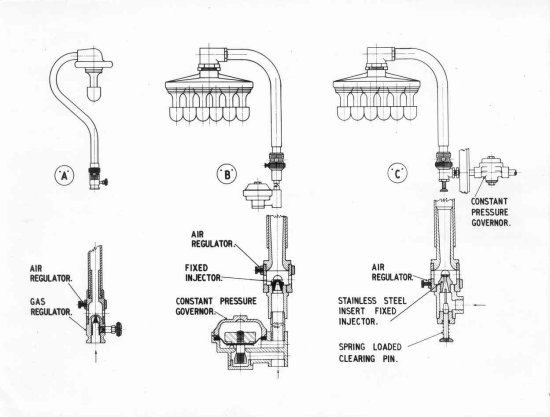
Superheated cluster burners (above)
These illustrations show burners used in traditional lanterns with bottom or side entry. ‘A’ is the common 2 lt superheated burner used as a conversion burner when upgrading lanterns from open flame or upright mantle.
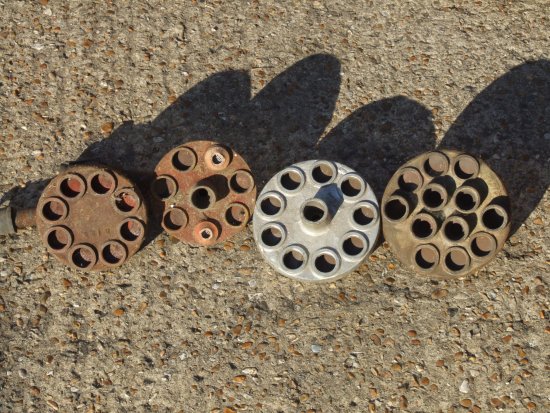
Several large cast iron multiple mantle superheaters, from 8 to 12 mantles.
Five different cast iron superheaters from 8 lt to 12 lt. The mantle arrangement in some superheaters allows for a ‘turn-down’ arrangement to reduce the illumination after midnight by a separate feed to certain of the ports.
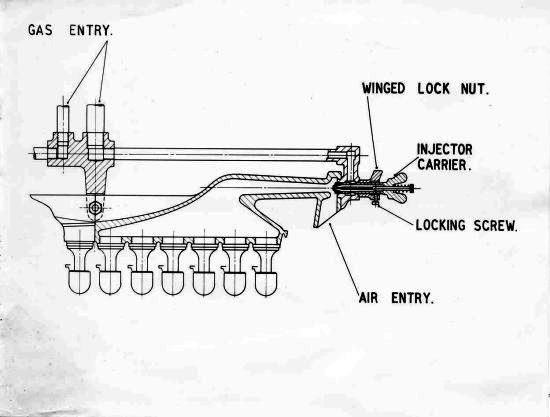
Superheated in-line burner – 1951 (above)
By placing mantles in a row, this burner provides directional illumination in the same way as a tubular electric lamp. The ‘London’ lamp uses a burner of this type and adds reflectors along the length of the burner to control the vertical spread.
NOZZLES
The variety of nozzles manufactured for the wide range of mantles is huge but, as we are concentrating on the world of Sugg it is just a little less complicated, especially if we take the more recent or perhaps ‘later’ versions first. Once it had been established that a cluster of small mantles was better than simply making mantles larger to obtain more light – mostly because the smaller mantle was stronger – the mantles used with the ‘superheaters’ as shown just above, were mostly the No.2 size with No.1 size on smaller 2 and 3 lt superheaters. The larger No.3 mantle tended to become the standard for domestic wall brackets and was certainly used widely by Veritas, however the threaded end was quite different. You can see from the pictures of the large superheaters above that the thread is quite large – in fact it is 3/4″ BSP (British Standard Pipe). The BSP threads are probably the oldest in existence and used all over the world as the use of gas grew and are still in use today. You can find thread charts easily which will give all the relevant details. A quick guide for 3/4″ BSP is that it is approximately 1″ across the top of the thread. (The BSP sizes relate to the interior bore size as this is relevant to the amount of gas or fluid that they can carry). Sugg used this large size because of the trumpet shaped form of the nozzle developed to help the hot products dissipate from the mantle. It also kept a distance between mantles that I suspect they determined was optimum. When it came to interior fixtures and the need to increase performance there would not have been room to fit 2 or even 3 nozzles/mantles within a modest size wall bracket so the nozzle shape was changed and the thread connection became female.
What I have described as the ‘Veritas’ type of nozzle also has a female thread of a coarse size 5/8″ x 14 t.p.i. for which a double-ended brass bush was produced often with 1/2″ x 26 t.p.i. which is a brass size. I believe this is simply because it is – or perhaps was – difficult to make fine threads in ceramic materials which, themselves, are fairly coarse and subject to chipping and I guess eventually stripping out.
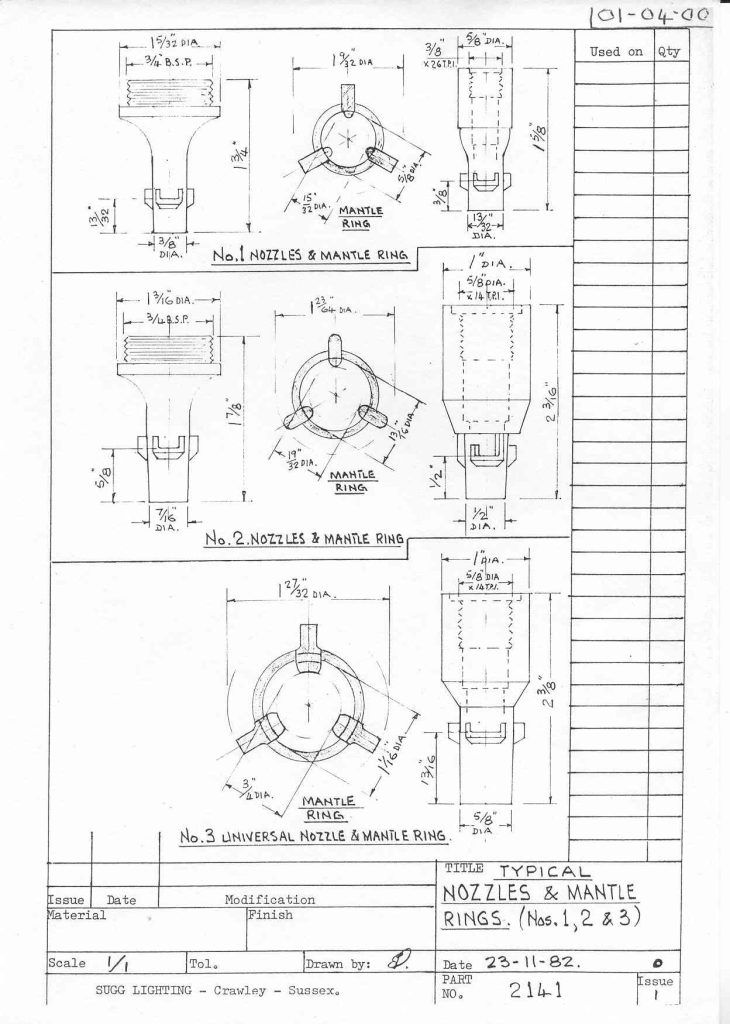
The hand drawn drawing above illustrates the most common nozzle and mantle combinations with the associated mantle rings that fit the 3 lugs or sockets on the nose of the nozzles. This drawing was done in 1982 at Sugg Lighting in order to clarify the most common arrangements that we had come across since re-starting the manufacture of gas lighting and it is still in demand today so I have just added it in 2022 to assist anyone with this detail. There are other pieces of information regarding nozzles and many of the Sugg sales booklets carry illustrations.
UNDER CONTINUOUS DEVELOPMENT – PLEASE TRY AGAIN LATER
Copyright © Chris Sugg 2006-onwards
Back to ‘Burners & Controls‘
or
Back to ‘Lighting‘

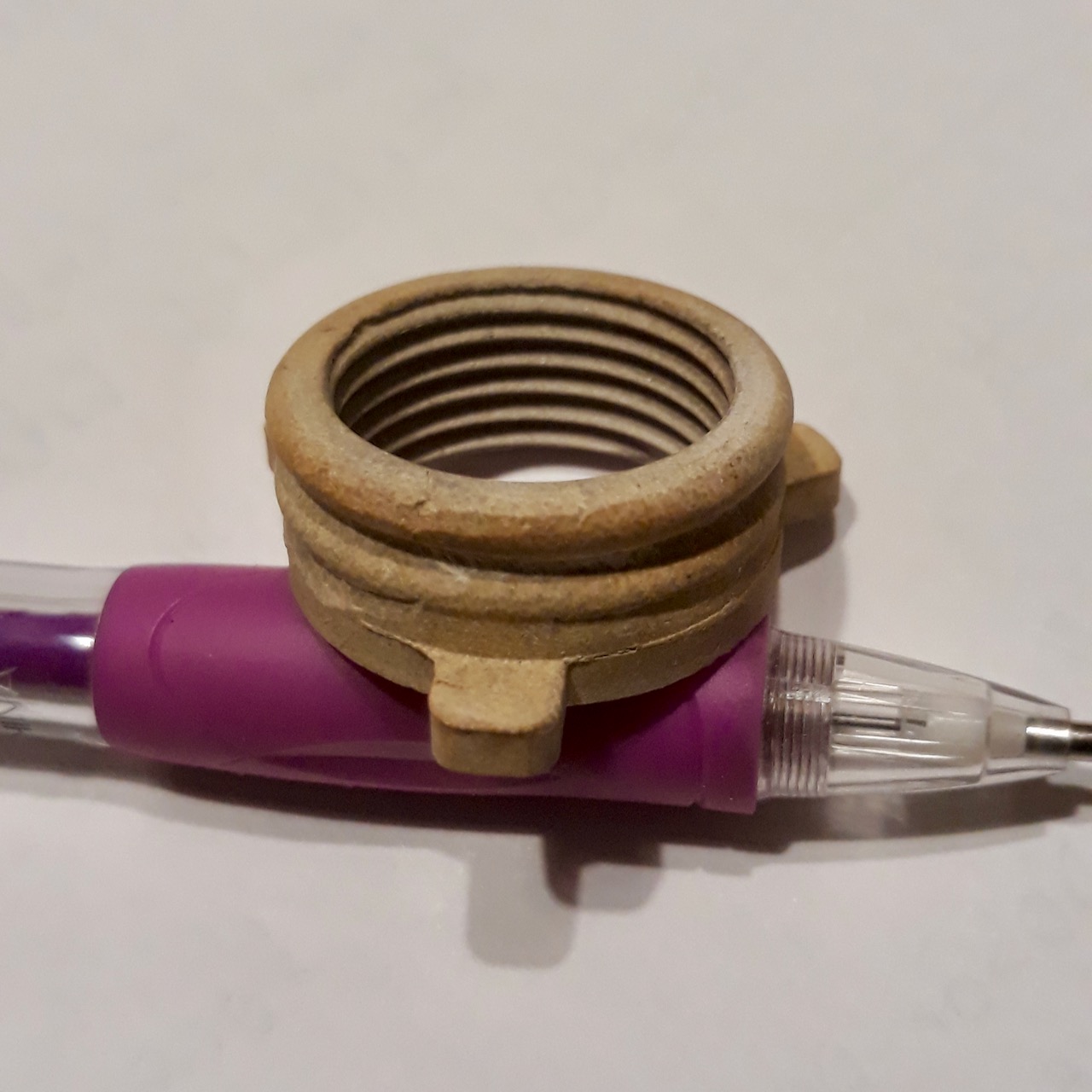
14 responses
Hi ,
Greetings from India
3rd generation manufacturing Gas Mantles in India.
Would love to work together.
Send details to the email address!
Thank you very interesting! I have inherited two gas lights in my beach hut which I have used for 25 years. I have replacement mantles 3789 for the hanging lamp but my wall lamp has had same mantle all this time and has only just gone! I can’t work out replacement…. the lamp has number 774818 on it, is this the mantle number also, do you think? Would more than one fit? Love the light these give
Can you send me a picture of the lamp, Sue – the number doesn’t mean anything to me so not a Sugg lamp but I can probably recognise the mantle you need. I have supplied a lamp for a beach hut in recent times! Good use!
Hi Good article. I need some help trying to source some ceramic nozzles for some gas lights. Have been approached by our cities maintenance organisation to refurbish our main street gas lights (42). Some require mantle replacements which we have, however the ceramic nozzles (18) are broken and would also like to stock some additional nozzles for future replacement. I can send details via email if you can assist. I am a Gasfitter from Whanganui in New Zealand. Cheers for now.
Hi Kirk, I will send you an email with some dimensioned drawings and pictures for you to compare. Do send me some details and pictures as I didn’t know there were so many gas lamps in your part of NZ.
Greetings Mr Sugg
Thank you for a very interesting website. In my youth in the sixties, I was enamoured by gas lighting and collected several gas brackets including one with a cut glass gas conduit to the burner. I remember seeing propane gas powered temporary traffic lights at road works, they had mantles behind a reflector with the usual coloured filter for traffic lights. They must have had some kind of clockwork valve system to sequence the lights which no doubt had pilot flames
I’ve never been able to find any documentation on these. Have you come across them?
Regards
Peter Jameson
Hello Peter,
Yes, I have a glass gas wall bracket but I guess it would be frowned on today – like so many things! As the electricians started making various traffic control devices Suggs were not going to be outdone and produced many equivalent devices although it became clear that there would be many difficulties. Take the flashing Belisha beacon. I know that they did make and demonstrate a gas Belisha but I don’t have any confirmation that it ever went into production! I have not seen a gas traffic light I am afraid so your guess is as good as mine as to how it might operate. If you do find out please let me know!
Thank you Chris
Your thoughts are much appreciated. I had no idea that a gas Belisha beacon had been made, but like the traffic lignt I suspect it was trialled by the local councils and abandoned quite quickly so only a few lucky oldies like me will have been lucky enough to see them just by chance.
As you will know, there were many innovations by the gas companies at the advent of the electric light in an attempt to imitate and survive the electric technology. A gas wall switch for domestic gas lighting for instance and even a gas timeswitch for gas street lighting; both of which I’ve seen in my local antiques shop. Sadly, I didn’t realise the rarity of them and so didn’t buy them.
Regards
Peter
Peter, I think the gas light switch is a classic of the gas industry trying to match the electric facility. There were several approaches from mechanical wires to pneumatic tubes for domestic applications and other clever valves that could turn on all the gas lamps in a railway marshalling yard! As for the gas time switches, the Horstmann company produced a whole range of clockwork switches from simple on/off twice a day to a clock that automatically adjusted the switching to match the change in daylight mechanically.
You can still find clockwork controllers, as they were called, made by several companies but don’t forget that there are two parts, the clockwork mechanism and the gas valve that normally lock together simply. Chris
Hello Chris,
I retail both soft and hard gas mantles. We’re looking for a source of ceramic nozzles to suit M3769, M3773, and M3772 inverted mantles, and notice your response of 9 Nov 2018 offering to email drawings and pictures to help ID some items. The sample ceramic nozzle I have for a M3769, is 60mm long and has an internal thread which looks like 5/8″ x 13TPI. Any and all information will be greatly appreciated.
Regards, and thanks in anticipation,
Paul Kennerley, sa***@************co.nz
I have replied by email and also added the nozzle drawing to this website.
Hi there, I wonder if I could ask you a couple questions on these mantles?
1, do all Veritas mantles contain Thorium?
2, to what do you attribute the high prices, some are selling for £25 each on eBay?
I’ve recently purchased a batch as I sell radioactive curios and I was lucky to buy a box of Veritas M3772 bijou fitting new old stock mantles.
The article above is superb by the way.
Thank you.
Hi Wayne, original Veritas mantles made by them up to about 1990 at a guess will have thorium. You can now buy both made by the Indian firm that has cornered the market by buying up all Veritas and Welsbach machinery and setting their own prices which I believe will probably sink the gas lighting market unless someone else can compete. At present I think they are the only manufacture and they are called Indo International. They have been around a long time and make various gas appliances. They only supply in pre-paid bulk to recognised dealers so old stock is about the only alternative and some people are asking ridiculous prices. It was the radioactive aspect of the fluid used to soak the ‘sock’ material that was banned by the UK that eventually forced Veritas out of London to Malta after first bringing in pre-soaked material which got over keeping the bulk liquid but could only get away with it for a while.
Regards, Chris